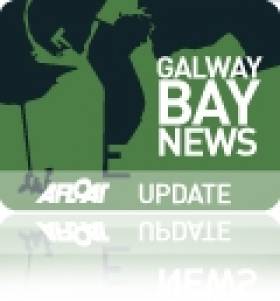Displaying items by tag: Westmeath
Lough Ree Locals Praise New RNLI Lifeboat Station
#Lifeboats - RTÉ News has a video report on a memorial to lives lost on the Shannon recently installed at the location of Lough Ree's new lifeboat station.
Relatives of those lost to the waterway spoke of their appreciation for the setting up of the new search and rescue base for the mid-Shannon after a decade of campaigning.
As reported on Afloat.ie last July, the RNLI's 44th lifeboat station in Ireland - located at Coosan Point in Athlone - Co Westmeath, has been welcomed as a search and rescue asset on Lough Ree and the Shannon.
Some €150,000 has been invested in the temporary facilities, from which volunteers operate the B class Atlantic 75 lifeboat Dorothy Mary, on a year-long trial basis.
According to RNLI Lough Ree's Matt Harte, the new station was among the busiest in Ireland last year, with up to 20 call-outs in its six months of operation thus far.
#RNLI – The RNLI's 44th lifeboat station in Ireland has officially been put on service and become a declared search and rescue asset on Lough Ree. The new lifeboat station is based at Coosan Point in Athlone, County Westmeath.
The RNLI will operate a B class Atlantic 75 lifeboat from temporary station facilities with the cost of the set-up estimated to be around €150,000. The station's lifeboat Dorothy Mary has come from the existing RNLI relief fleet and was previously on service in Red Bay, County Antrim and Kinsale in Cork. Following a year long trial period the RNLI will then make a decision on establishing a permanent lifeboat station.
Following meetings last year a team of volunteers was selected to operate the station and crew the lifeboat. There has been an intensive period of training for the volunteer lifeboat crew, which has included months of training on the Lough and visits to the RNLI training college in Poole.
There are currently eighteen volunteer lifeboat crew including six helms. Their backgrounds range from a bouncer, marine engineer, a fireman, a postman to a printer. There are also three members of the Herraghty family involved with sisters Oona and Niamh joining their brother Donie on the crew.
Lifeboat Operations Manager Damien Delaney is very proud of the new station, which he and other local people had been active in securing for the area. He commented, "This is a great day for everyone involved in the setting up of this station. For years the people of the town of Athlone and the surrounding counties of Westmeath, Longford and Roscommon have supported the RNLI with street collections and various fundraising events. Even though we did not have a station on Lough Ree we knew how important it was to have the lifeboat service in Ireland.
The late Sean Fitzsimmons started things rolling many years ago with myself and Vincent Rafter then taking up the challenge. We received great support and encouragement from everyone involved with the RNLI at both Swords and Poole. To see this group of young volunteers coming together and training with the lifeboat and now going on service is a very proud day for me."
Representations were made back in 2010 to the RNLI by the Inland Waterways Association of Ireland with support from various statutory bodies including the Irish CoastGuard, for a declared search and rescue asset to be present on the lake.
The Lough is approximately eighteen miles long and six miles at its widest point. It is a popular spot for visitors including anglers, rowers, pleasure cruisers, swimmers and sailors.
Tristan Murphy RNLI Deputy Divisional Inspector for Ireland added, "On behalf of the RNLI I wish everyone involved at the new lifeboat station in Lough Ree every success. From the initial meeting right through to the start day, the enthusiasm has been overwhelming. I am delighted that Lough Ree now has its own lifeboat.
I would also like to thank everyone involved in getting the lifeboat station ready for service. Special thanks must also be given to Westmeath County Council who provided the site for the lifeboat station and Lough Ree Yacht Club for allowing us to use their facilities for crew training."
As previously reported on Afloat.ie the station has already had its first callout involving a barge becoming grounded on rocks. One person was assisted and brought to safety.
Athlone Man to Swim Galway Bay for Charity
The Westmeath Independent reports that Athlone man Jim O'Connor is preparing to swim 13km across Galway Bay for charity.
Jim will join 25 other brave swimmers on Sunday 20 August in the Frances Thornton Memorial Galway Bay Swim in aid of Cancer Care West, which is now in its sixth year.
The swim route runs from Auginish in Clare to the Blackrock Diving Tower in Salthill - and Jim is already swimming up to 30km each week at his local pool to ready himself for the challenge.
He is also halfway towards his fundraising target of €1,000 - to which readers can contribute at MyCharity.ie.
The Westmeath Independent has more on the story HERE.


























































